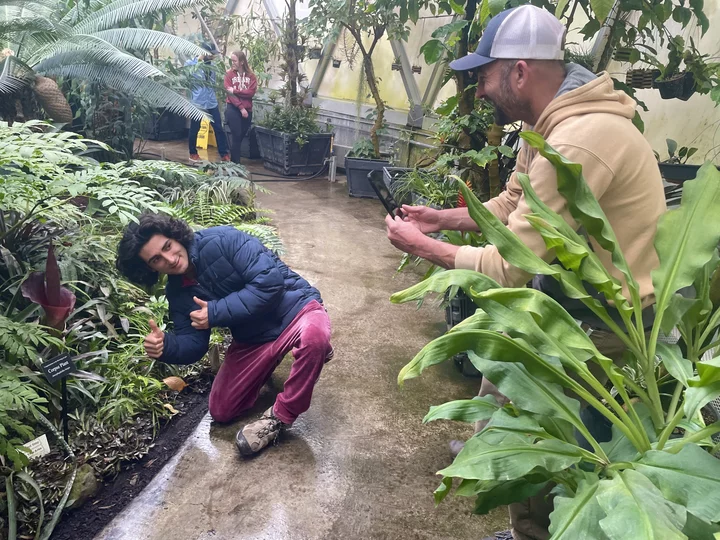Amorphophallus konjac, commonly known as the corpse flower or corpse plant, blooms in the Cal Poly Humboldt greenhouse. | Photos by Ryan Burns.
###
On Wednesday morning, students filed in, one or two at a time, to the humid air of the geodesic Dennis K. Walker Greenhouse on the campus of Cal Poly Humboldt Wednesday morning, excited to get a look and a whiff of the resident corpse flower (scientific name: Amorphophallus konjac) that has bloomed for the first time since 2021.
The flower — or, more precisely, the inflorescence, a stalk of many flowers — looked frankly excited, too. (Fun science fact: Amorphophallus comes from the ancient Greek for shapeless or deformed penis.)
A sour, earthy smell hits you as you enter the greenhouse, but some brave students were compelled to lean down, dipping their nose into the burgundy collar (or spathe) for a deep inhale of the rotting flesh aroma that gives this plant its name.
“Dead rat,” one student offered as a descriptor.
A Cal Poly Humboldt student poses for a photo with the pungent plant.
###
Native to warm, subtropical to tropical areas of southwest China, the Amorphophallus konjac can grow up to 36 inches wide, with the inflorescence growing as tall as six feet. The burgundy bloom currently up on campus has more modest proportions, but students were still impressed.
“The ones that really bring people in in droves … is the Amorphophallus titanum,” said assistant greenhouse manager Andy Goldman. “It’s gigantic.”
An excited student nearby said, “There’s one in San Diego; I missed that one, though.”
While the climate here in Humboldt County is quite different than this plant’s native environment, Goldman said he once saw an Amorphophallus konjac bloom in the backyard of his home in Cutten.
“Apparently the people that owned the house before us were big gardeners and they planted bulbs,” he said. “It was in a pretty specialized little spot — south-facing, next to the foundation of a garage so it stays nice and warm. But yeah, I’ve lived that for 20 years and I’d never seen in flower. It flowered seven or eight years ago and I haven’t seen it since.”
The corpse flower’s pungent smell serves a botanical purpose: attracting the dung beetles, carrion flies and other carnivorous insects that serve as its primary pollinators, who may be searching for a suitable site to lay their eggs.
“Once pollination is complete, the flower collapses, a process that takes only two to three days,” Cal Poly Humboldt explains on its website. For members of the public wishing to get a gander at this beauty, the greenhouse is open Tuesdays through Fridays from 10 a.m. to 2 p.m., though, again, the bloom won’t last for long.
To sum up: Its scientific name means “malformed penis,” it smells like death and it doesn’t last very long. And yet somehow it still manages to please people. Good for you, buddy.


CLICK TO MANAGE